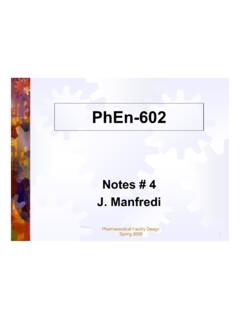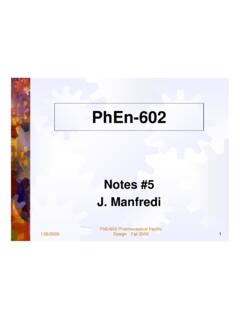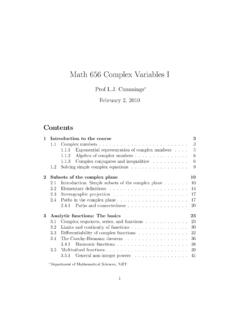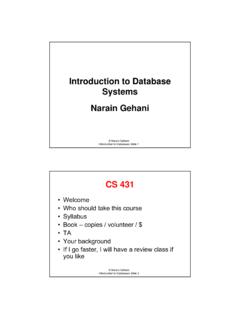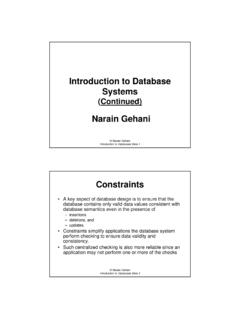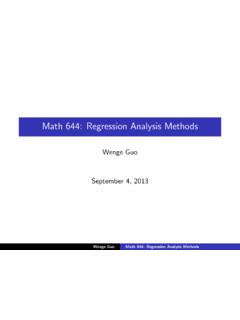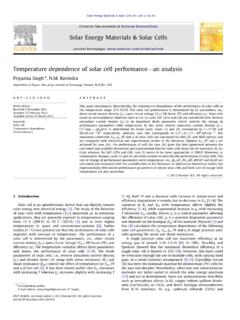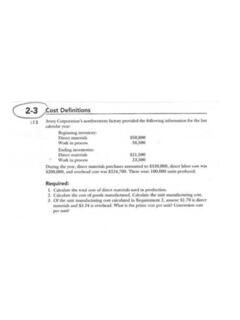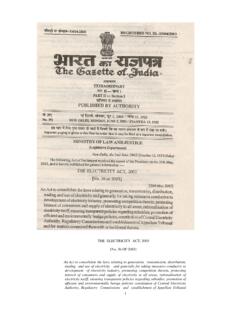Transcription of ELECTRICITY & MAGNETISM Lecture notes for Phys 121
1 File: & MAGNETISML ecture notes for Phys 121Dr. Vitaly A. ShneidmanDepartment of Physics, New Jersey Institute of Technology,Newark, NJ 07102(Dated: January 22, 2022)AbstractThese notes are intended as an addition to the lectures givenin class. They are NOT designedto replace the actual lectures. Some of the notes will contain less information then in the actuallecture, and some will have extra info. Not all formulas which will be needed for exams arecontained in these notes . Also, these notes will NOT containany up to date organizational oradministrative information (changes in schedule, assignments, etc.) but only physics. If you noticeany typos - let me know at I will keep all notes in a single file - each time you canprint out only the added part. A few other things:Graphics: Some of the graphics is deliberately unfinished, so that we have what to do in : can be skipped upon the 1st reading, but will be useful in the : these will not be represented on the exams.
2 Read themonly if you are reallyinterested in the : Introduction2A. Vectors21. Single vector32. Two vectors: addition33. Two vectors: scalar (dot) product54. Two vectors: vector product6B. Fields81. Representation of a field; field lines102. Properties of field lines and related definitions10II. Electric Charge12A. Notations and units12B. Superposition of charges12C. Quantization of charge12D. Charge conservation12E. The Coulomb s Law14F. Superposition of forces15G. Reaction of a charge to electrostatic and other forces17 III. Electric field22A. Field due to a point charge221. Definition and units222. Vector Fields and Field Lines23B. Field due to several charges241. Definition and force on a charge in a field242. Superposition of fields25C. Electrostatic Field Lines (EFL)291. Field lines due to a dipole29D. Continuos charge distribution30IV. Gauss Theorem330A. Quantification of the number of lines33B.
3 Deformations of the Gaussian surface33C. Definition of the flux36D. Gauss theorem37E. Gauss Theorem (GT) and Coulomb s law37F. Applications of the GT381. Charged spherical shell392. Uniformly charged sphere403. Uniformly charged infinite line414. Uniformly charged non-conducting plane42G. A metal conductor44V. Electrostatic potential (EP)45A. Definitions, units, Work and energy in electrostatic field471. Conservative forces47C. Interaction of two charges48D. Potential due to a point charge48E. Relation to electric field521. Potential from field522. Field from potential53F. Conductors55VI. Properties of a conductor in electrostatics561. Field near the surface of a conductor59 VII. Capacitance60A. Definitions, units, Definition60B. An isolated sphere61C. A spherical capacitor62D. Parallel-plate capacitor63E. Capacitor with a dielectric641F. Capacitor and a battery66G. Energy66H.
4 Connections of several capacitors671. Parallel672. Series67I. Physics of the dielectrics70 VIII. Current71A. Definitions and units71B. Resistance of a wire72C. Relation to field72D. Power731. Single resistor732. Simple connections73E. Series and parallel connections73F. Ampmeter and voltmeter751. Branching of current in parallel connections76G. Microscopic picture of conductivity77H. Dielectric77I. Liquids (electrolytes)78IX. Circuits79A. The reduction method79B. The real battery80C. The potential method81D. Multiloop circuits and the Kirchoff s Vitaly A. Shneidman, Phys 121, 1st LectureI. INTRODUCTIONA. VectorsAvectoris characterized by the followingthreeproperties: has a magnitude has direction (Equivalently, has several components in a selected system of coordi-nates). obeys certain addition rules ( rule of parallelogram ). (Equivalently, components ofa vector are transformed according to certain rules if the systemof coordinates isrotated).
5 This is in contrast to ascalar, which has only magnitude and which isnotchanged when asystem of coordinates is do we know which physical quantity is a vector, which is a scalar and which isneither? From experiment (of course). Examples of scalars are mass, kinetic energy and(the forthcoming) charge. Examples of vectors are the displacement, velocity and addition Single vectorConsider a vector~awith componentsaxanday(let s talk 2D for a while). There is anassociated scalar, namely the magnitude (or length) given by the Pythagorean theorema |~a|= a2x+a2y(1)Note that for a different system of coordinates with axesx , y the componentsax anday can be very different, but the length in eq. (1) , obviously, will not change, which just meansthat it is a operation allowed on a single vector is multiplication by a scalar. Note that thephysical dimension ( units ) of the resulting vector can be different from the original, as in~F=m~ Two vectors: ~A~B~CFIG.
6 1: Adding two vectors:~C=~A+~B. Note the use of rule of parallelogram (equivalently, tail-to-head addition rule). Alternatively, vectors can be added bycomponents:~A= ( 2,1),~B= (1,2)and~C= ( 2 + 1,1 + 2) = ( 1,3).3 For two vectors,~aand~bone can define their sum~c=~a+~bwith componentscx=ax+bx, cy=ay+by(2)The magnitude of~cthen follows from eq. (1). Note that physical dimensions of~aand~bmust be Addition of vectors plays a key role in E&M in that it enters the so-called super-position principle .43. Two vectors: scalar (dot) productIf~aand~bmake an angle with each other, their scalar (dot) product is defined as~a ~b=abcos ( )or in components~a ~b=axbx+ayby(3)Example. See Fig. 1.~A= ( 2,1),~B= (1,2) ~A ~B= ( 2)1 + 1 2 = 0(thus angle is 90o).ExampleFind angle between 2 vectors~Band~Cin Fig. : cos =~a ~bab(4)In Fig. 1:~B= (1,2),~C= ( 1,3) B= 12+ 22= 5, C= ( 1)2+ 32= 10cos =( 1) 1 + 3 2 5 10=1 2, = 45oA different system of coordinates can be used to evaluate~a ~b, with different individualcomponents but with the same result.
7 For two orthogonal vectors~a ~b= 0 in anysystem of coordinates. The main application of the scalar product isthe concept ofwork W=~F ~r, with ~rbeing the displacement. Force which is perpendicular todisplacement does not work!Preview. We will learn that magnetic force on a moving particle is always perpendicularto velocity. Thus, this force makes no work, and the kinetic energyof such a particle : Prove the Pythagorean theoremc2=a2+ Two vectors: vector productAt this point we must proceed to the 3D space. Important here is the correct system ofcoordinates, as in Fig. 2. You can rotate the system of coordinates any way you like, butyou cannot reflect it in a mirror (which would switch right and left hands). If~aand~bmakexyzxyxyzFIG. 2: The correct, right-hand systems of coordinates. Checkpoint - curl fingers of the RIGHT hand fromx(red) toy(green), then the thumb should point into thezdirection (blue).
8 (Note thataxes labeling of the figures is outside of the boxes, not necessarily near the corresponding axes;also, for the figure on the right the origin of coordinates is at thefarend of the box, if it is hardto see in your printout).an angle 180owith each other, their vector (cross) product~c=~a ~bhas a magnitudec=absin( )The direction is defined as perpendicular to both~aand~busing the following rule: curl thefingers of the right hand from~ato~bin the shortest direction ( , the angle must be smallerthan 180o). Then the thumb points in the~cdirection. Check with Fig. the order changes the sign,~b ~a= ~a ~b. In particular,~a ~a=~0. Moregenerally, the cross product is zero for any two parallel Diagram:6 FIG. 3: Example of a cross product~c(blue) =~a(red) ~b(green). (If you have no colors,~cisvertical in the example,~ais along the front edge to lower right,~bis diagonal).i j k i xj =k j xk =i k xi =j i xk =-j , now a system of coordinates is introduced with unit vectors i, jand kpointingin thex,yandzdirections, respectively.
9 First of all, if i, j, kare written in a ring , thecross product of any two of them equals in clockwise direction the third one, i j= k , j k= i , k i= Fig. 1:~A= 2 i+ j ,~B= i+ 2 j7~A ~B= ( 2 i+ j) ( i+ 2 j) = ( 2) 2 i j+ j i== 4 k k= 5 k(Note: in Fig. 1 kgoes out of the page; the cross product~A ~Bgoes into the page, asindicated by - .)More generally, the cross product is expressed as a 3-by-3 determinant~a ~b= i j kaxayazbxbybz = i ayazbybz j axazbxbz + k axaybxby (5)The two-by-two determinants can be easily expanded. In practice, there will be many zeroes,so calculations are not too Vector product is most relevant to MAGNETISM ; it determines, magneticforce on a particle in a field,~F=q~v ~Bwithqbeing the charge,~vthe velocity, and~Btheintensity of magnetic field at the location of the See Fig. 1.~A ~B= k(( 2)2 1 1) = 5 kB.
10 FieldsSo far we were dealing with scalars or vectors attributed to asingleparticle (or a singlepoint, if you prefer). Consider now a much more general situation when a scalar or avector is attributed toeverypoint in space. This brings us to a concept of afield, scalaror vector, respectively. Field can also depend on time. A good example of a scalar fieldis the temperature (or pressure) map which you see in the weatherforecast. Similarly, thevelocities of the air flow (usually superimposed on the same map) give avector of scalar and vector fields: weather maps. Top - pressure field (scalar); linesconnect points with identical pressure. Lower: wind velocity fields;left - regular flow fromhigh to lower pressure, right - turbulent flow (note regions with non-zero circulation, tor-nadoes ). The left maps are similar to those for potentialVand electrostatic field~Eof anelectric dipole.
